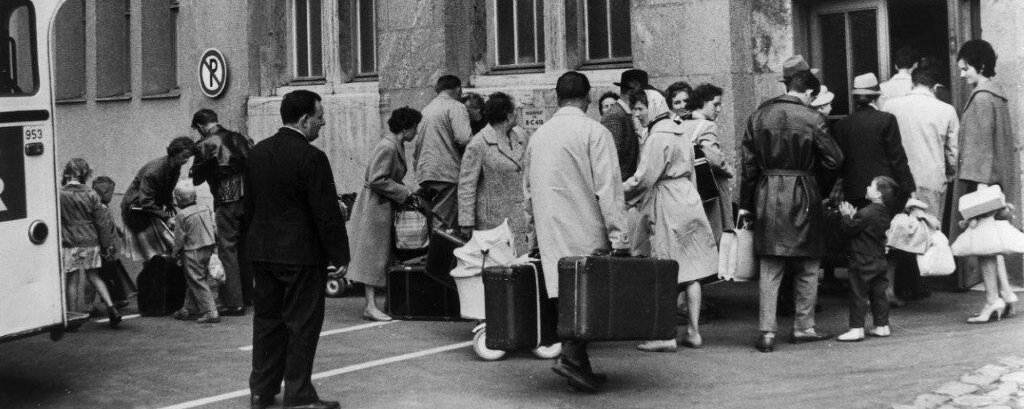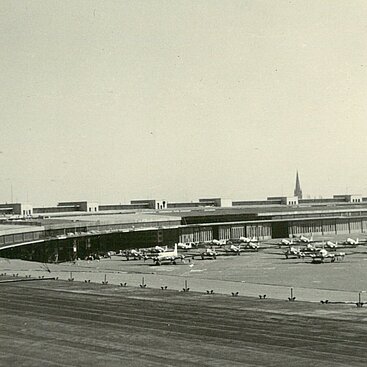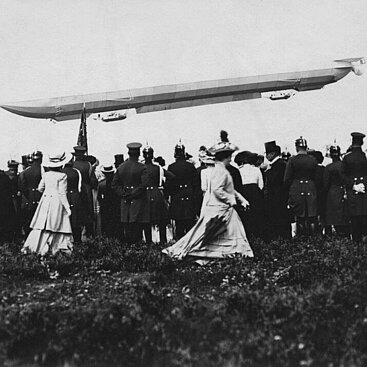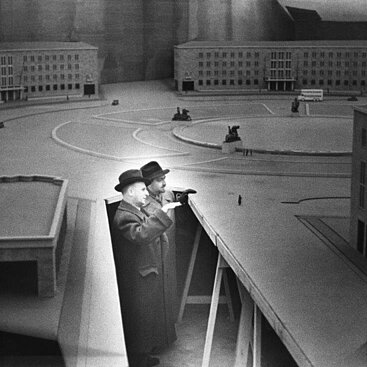Vanishing point of Tempelhof
Between 1952 and 1961, thousands of people left Soviet sectors of the city or GDR West Berlin every month in the direction of Federal Republic of Germany. Even refugees from East European countries initially headed for West Berlin. The conditions of their departures from Airport Tempelhof as well as the escape circumstances are still insufficiently researched but the importance of the airport in the American sector can be outlined by now.
The stream of refugees to West Berlin
Separate currency reforms in three western zones on the one hand and the Soviet zone on the other deepened the division of Germany in 1948. The blockade of all land and waterways in the three western sectors of Berlin, the airlift of Western Allied forces for supporting their Berlin sectors, the end of a common German government due to relocation of offices to West-Berlin and moving out of western city councillors from the city hall as a reaction to permanent disruptive actions of SED made the division more probable day by day.
In November 1948 – during Berlin blockade – West-Berlin senate organised the first registration office for refugees from the Soviet occupied zone (SBZ) and Soviet sector of Berlin in Charlottenburg. In January 1949, the “Centre for political east zone refugees” was built in Kantstraße. According to the information of Berlin’s Tagesspiegel, 150 people had already reported there on 5th January 1949, who wanted to permanently relocate to the western sector. Those who could not accommodate with relatives or friends received a place to sleep in a camp after the registration. Food brand of the lowest category was provided to new arrivals. In June 1949, the first transit camp could be built in Zehlendorf only for refugees from SBZ/GDR. In addition, there were diverse mass accommodations distributed across the city.
Around 7,500 immigrants per month came in the first six months of 1950 alone. Berlin, a contact point for the escaped and exiled from former east German areas, was heavily under pressure due to high unemployment and dramatic housing shortage in the wake of war destructions. The city could and wanted to accept no “economic refugees”. The underlying tendency of early West Berlin refugee policy was strict opposition to those who could not made a convincing argument about the political reason of their flight. On 22 August 1950, the German Parliament passed a “Law on the accommodation of Germans in the Federal Territory” – the emergency accommodation law. It states that a permanent residence permit for the Federal Republic of Germany is issued by the accommodation committee after the notification in the camps intended for the same. According to the law, this “special permit” must not reject people who “have left the Soviet occupied zones or Soviet sector due to an imminent danger for life and limb, for personal freedom or for other imperative reasons”.
In the Federal Republic, there were two transit camps, in Gießen and Uelzen, in which official procedures were carried out. From 1953 onwards, more and more refugees were accepted. The economic upswing in the Federal Republic eased their integration. Their accommodation was also a question of prestige under the conditions of system confrontation.
Start into the future
In the summer of 1951, the jurisdiction of the transit camp was extended to West Berlin. This relieved West Berlin from the cost of accommodation process and factored into the distribution of refugees in federal states. From February 1952 onwards, the city could redirect 80 per cent of the accepted immigrants – in 1951 it was an average of 4,000 people per month – to the federal territory. As GDR developed from a massive migration of young well-educated people of caused great economic losses and persistent flow of refugees revealed its failed policy, the SED government put pressure on refugees in West Berlin as well as their families in GDR with the help of State Security Service.
Transport of immigrants via strictly monitored transit routes was out of the question. Hence, Airport Tempelhof gained importance for GDR refugees. Airway was the only unmonitored connection between West Berlin and the Federal Republic, which could be considered “safe” despite isolated incidents. The refugees accepted in Marienfelde were flown out from Tempelhof at the expense of the Republic with a “departure portion” from which the district of Neukölln was provided. If the rush was too large, the West Berlin authorities would arrange immediate departure of the new arrivals. Depending on development based on internal and external policies, the number of refugees increased significantly in 1950s although in the beginning almost two third of all applications for a residence permit for West Berlin and Federal Republic were rejected.
On 26 May 1952, the GDR government closed the inner-German border and let a five kilometre wide restricted zone be built along the demarcation line to Federal Republic. The last flaw for the road to Federal Republic of Germany was divided Berlin. In 1953, West Berlin could open the transit camp Marienfelde with the support of the Federal Government. Up to 1961, the year of the Building of the Berlin Wall, admission of 4,000 to 21,000 people per month was recorded.
After 13 August 1961, another 20,000 refugees reached West Berlin and just 3,614 in the entire year of 1962. This decline manifests itself in Berlin transport of the allied airlines. The aircrafts of Pan American Airways and British European Airways were now no longer working to capacity. From the perspective of airlines, reduction in flight plan was necessary. The Federal Government arranged for a passenger subsidy and could hence significantly increase the demand for Berlin flights by the summer of 1962.
On the former airport ground on Tempelhofdamm, the “green barrack”, which is marked as “building 500” today, is still reminiscent of the thousands of GDR refugees, who started from here in the Federal Republic and hence in a new uncertain phase of life. The details of functioning and use are still being researched.
LOT – “Often landed in Tempelhof”
For another group of refugees, Airport Tempelhof was not the starting point but the destination, about which there still are very few sure facts known. Aircraft hijackers, coming from or via Poland, landed on the airport in the American sector. Until 1993, Tempelhof was used as a military airport of US armed forces. At first, the Americans were not considered politically reliable due to the extent of their troops in the population stationed in Berlin. The US city commander was the Commander in Chief of all the allied troops in West Berlin in a crisis situation; “his” airport was only 80 km away from the Polish border.
13 hijackings were documented between 1963 and 1983; the newspapers reported almost 20 cases. The Americans were embarrassed by these flights; from a legal point of view, they were mostly avenging aircraft hijacking. In July 1963, a Major of the Polish Air Force escaped with his wife and two children in a propeller aircraft of type TS 8. Because he was optimally familiar with the surveillance technology in Poland and GDR being an instructor, he managed the escape in a low-level flight. With his small aerobatic training plane, the Polish Major exercised landing on motorways. This way, he landed on the taxiway of the airfield without contacting the tower and requested for political asylum. For the Time Magazine dated 19 July 1963, he was the first refugee, who had reached West Berlin by air.
Another spectacular escape, which received a huge media response and literary and cinematic adaptation, was the hijacking of a LOT Tupolew 134 in August 1978. On the flight from Gdansk to the East Berlin airport Schönefeld, a GDR citizen abducted a stewardess and forced the pilot to land in Tempelhof. Other than the abductor and his long-time acquaintances, with whom he had planned the escape after an enormous number of rejected immigration applications, the remaining GDR citizens remained in West Berlin. The Americans rejected a Polish extradition request and tried them both in front of an American court.
The United States Court for Berlin convened in the airport building under Judge Stern. While the procedure against the woman was discontinued owing to a formal error, a jury of twelve German jurors - all citizens of the American sector - sentenced the abductor for hostage-taking to a prison sentence of nine months, which was compensated for in remand. The jury pleaded “not guilty” to the charges attack on air transport, deprivation of personal freedom and personal injury.
The defendant had expressly described his emergency: Originally, both of them wanted to flee to Travemünde via Gdansk by ship with false passports. As their West German friend did not appear in Gdansk with identity papers, they (rightly) thought that their escape plans were revealed and saw no opportunity to return to GDR and hence abducted the LOT aircraft armed with a blank cartridge pistol.
St. Endlich, M. Geyler-von Bernus, B. Rossié
Literature
Wolfgang Benz, mission of democracy. The foundation history of the Federal Republic and emergence of GDR 1945-1949, Berlin 2010
Laurenz Demps, Carl-Ludwig Paeschke, Airport Tempelhof. History of a legend, Berlin 1998
Bettina Effner, Helge Heidemeyer, Fleeing in divided Germany, Berlin 2005
Helge Heidemeyer, Escape and immigration from SOZ/GDR 1945/1949-1961.
The refugee policy of the Federal Republic of Germany up to the construction of the Berlin Wall, contributions to the history of parliamentarism and political parties, Bd.100, Düsseldorf 1994
Elke Kimmel, “… it was unreasonable to expect remaining in GDR any longer.” GDR refugees in transit camp Marienfelde, Berlin 2009
Hans Przychowski, Airlifts to Berlin. The Allied air transport 1945-1990, Berlin 1996





